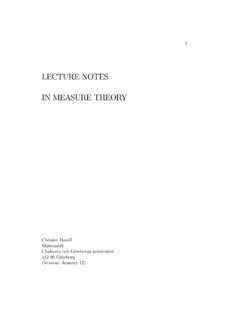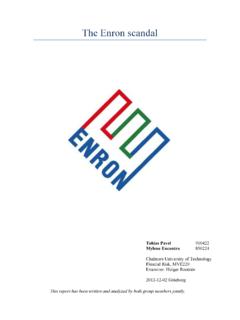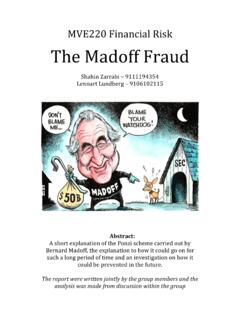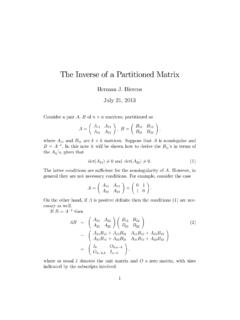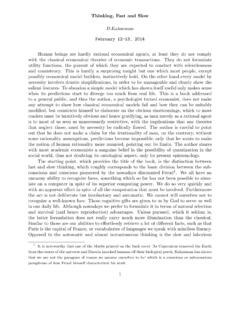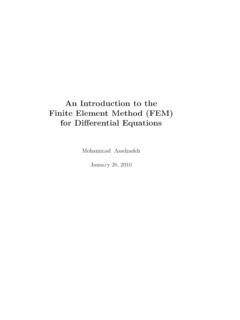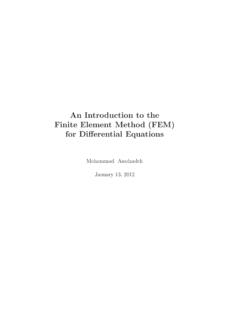Transcription of The Capital asset pricing model and the Arbitrage pricing ...
1 Gothenburg UniversityFinancial RiskMSA400 The Capital asset pricingmodel and the Arbitragepricing theoryAuthors:TrangNguyenOliviaStalinAba bacarDiagneLeonardAukeaSupervisors:Pr. HolgerRootzenDr. AlexanderHerbertssonThis report has been written and analyzed by all the groupmembers 15, 2017 The Capital asset pricing model and theArbitrage pricing TheoryLeonard Aukea, Ababacar Diagne, Trang Nguyen, Olivia StalinAbstractIn this work we review the basic ideas of the Capital asset PricingModel and the Arbitrage pricing theory .
2 Furthermore, we exhibit thepractical relevance and assumptions of these models. We show whatmake them successful for the pricing of assets. Indeed, the drawbackand limitations of these models will be addressed as : Capital asset pricing model , Arbitrage pricing The-ory, asset IntroductionBased on the pioneering work of Markowitz (1952) and Tobin (1958) for riskyassets in a portfolio, Sharpe (1964), Lintner (1965) and Mossin (1966) deriveda general equilibrium model for the pricing of assets under uncertainty, calledthe Capital asset pricing model (CAPM).
3 CAPM is a well-known and accepted single factor model , after four decadesCAPM is still one of the main alternatives in the estimation of expectedreturn or cost of equity for individual stocks (commodity derivatives, en-ergy/electricity markets, etc.) and other financial securities. This task iscentral to many financial decisions such as those relating to portfolio opti-mization, Capital budgeting, and performance evaluation. The measure ofrisk in the CAPM is given by the security s covariance with the market port-folio, the so-called market , the CAPM quantifies the expected rates of return of an asset withits relative level of market systematic risk (beta).
4 This explains why the1 CAPM is called often a single factor model . Another model for the estima-tion of asset returns is the Arbitrage pricing theory (APT). To improve thediscrepancy of the CAPM, the APT model was proposed by Stephen Ross(1976) as a general theory of asset pricing . His theory predicts a relationshipsbetween the returns of a single asset as a linear function of many indepen-dent macroeconomic factors. In a historical context, the CAPM was the firstcoherent framework answering the question of how expected returns and riskwere fact, as noted by authors in [15], the attraction of these model is thatit offers powerful and intuitively pleasing predictions about how to measurerisk and the relation between expected return and risk.
5 The CAPM and APTare simple asset pricing tools comparing to other probabilistic and , following authors in [12], the APT has generated an increasedinterest in the application of linear factor models in the study of capitalasset pricing and a large academic literature [15, 13, 14, 10]. As an illustra-tion some extensions and some modified versions of the CAPM have beendeveloped. For instance, the Conditional CAPM (CCAPM) models the time-varying property of the distribution of stock returns (cf [18]).
6 In addition, anapplication of the consumption-based CAPM ( pricing performance in sevenindustry sub-sectors in the Taiwan stock market) is presented in [11]. Here,the risk of a security is measured by the covariance of its return with percapita consumption and is called consumption beta. Theoretically, the con-sumption beta offers a better measure of systematic name only a few, using stock listed in the Korean stock exchange,authors in [21] present a comparative study by considering different versionsof CAPM and the APT models such as.
7 CAPM, APT-motivated models, theConsumption-based CAPM, Intertemporal CAPM-motivated models, andthe Jagannathan and Wang conditional CAPM , the CAPM and the APT have provided interesting and challeng-ing research topics [17, 8, 5, 27, 26, 7]. For instance, Bartholdy and Pearein [5] conducted a comparative study of the performance of this two modelsfor individual stocks. They make use of the Fama and French three-factormodel for the APT. As a result, they show that the Fama French model isat best able to explain, on average, 5% of differences in returns on individ-ual stocks despite the favor of the CAPM by practioners.
8 Moreover, whenthe risk levels are given by coherent risk measures such as VaR, CVaR, andWCVaR, authors in [4] presented the optimal portfolio choice problems and2some extensions of the classic Arbitrage pricing theory (APT) and refer the interested reader about these risk measures to [25, 16]. In [2],the so called conditional CAPM is discussed. Likewise, by making use ofa Kalman filter, Tobias and Frazoni model the conditional beta and theirapproach circumvents recent criticisms of this risk measure.
9 They tackle anumber of the issues by assuming that betas change over time following amean-reverting , Hwang and collaborators in [20] present a sharp idea of using thecredit spread as an option-risk factor and explain some limitations of thetraditional CAPM. They contribute to the option-risk CAPM literature byusing bond-credit-spread data as a proxy for default risk to control for theoption-risk characteristic of stocks. Their option-risk version of CAPM re-sembles the conditional CAPM. Another application of the CAPM and APTon the private equity asset class can be found in the recent paper [9].
10 Sincethese asset by nature are illiquid, the traded liquidity factor is included in theAPT model . Even tough, an outstanding review and historical walk-throughof the CAPM is presented in [22]. The author claims that the CAPM devi-ations is not due just to missing risk factors, hence the APT cannot be anattempt to correct recently, economically meaningful results with important policy im-plications are found by By Aabo and co-authors in [1]. They introduce thedegree of the internationalization as a new corporate risk and illustrate theirresults considered Scandinavian multinational firms.

